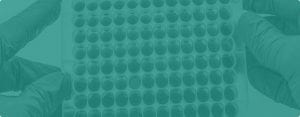ELISA
If you need to measure the concentration or presence of an antigen in solution, then the Enzyme Linked Immunosorbent Assay (ELISA) is one of the workhorses of the modern biomedical lab. From diagnostics to quality control, the ELISA has a huge number of uses: below is a brief introduction to ELISAs and a general ELISA protocol.
How do ELISAs work?
All ELISAs capture an antigen of some interest using immobilised antibodies to it, coupled with some form of detection step to which develops a measurable signal in proportion to the amount of antigen captured. By comparing the signal from unknown sample to a series of known concentration standards, the concentration of the antigen in samples can be determined.
This is the first post in a short series focussed on ELISAs. There are a few common variations, including the aforementioned sandwich ELISA, as well as direct, indirect and competitive ELISAs. We’ll also cover ELISpots, which use live cells rather than some biological matrix.
In this post we’ll offer a generalised ELISA protocol. ELISAs, while typically straight forward to actually run, can be pretty tough to develop from scratch. Fortunately, manufacturers of antibodies will more often than not offer some guidance on their specific products to get you started in the right place.
This series of posts is intended to be a guide to help you get going.
General ELISA Protocol
Reagents
- 96-well microplate
- Coating buffer: PBS (pH 7.4) or carbonate/bicarbonate (pH9.6) for coating
- Washing buffer: PBS + 0.05% Tween-20
- Blocking buffer: PBS + 1% BSA
Plate Preparation
- Dilute the capture antibody to the manufacturers recommended concentration to make about 10 mL of coating solution.
Antibodies are typically diluted either in PBS, or carbonate/bicarbonate buffer. Follow the manufacturers instructions.
Note: avoid using anything containing BSA/protein, as this will compete with your capture antibody for binding in the microwells.
- Add 100 μL per well of coating solution to the plate.
A multichannel pipette is ideal, and a huge timesaver.
- Cover with a plate sealer and incubate overnight at +4 °C.
- Aspirate each well, and wash with 200 μL of wash buffer. Repeat twice more for a total of three washes.
Tip: rap the plate smartly on some paper towels after washing to ensure all washing buffer is removed.
- Add 300 μL of blocking buffer to all wells of the plate and incubate at room temp for at least an hour. Ideally 2-3 hours.
This step uses the BSA in solution to bind to any remaining free binding sites in each microwell, ‘blocking’ the detection antibodies, antigen or other samples components from binding non-specifically to the plate.
Note: While the plate is blocking, remove samples to thaw and prepare any calibration standards or QC samples and diluted samples (if needed).
Ideally, samples, standards and QC samples (e.g. a high, medium and low) will be added in duplicate to the plate.
Also, this is great time to prepare an
elisa-plate-plan, so you know which samples should go where. Preparing and following a plate plan ahead of time will save you a lot of trouble.
Assay procedure
- Aspirate each well, and wash with 200 μL of wash buffer. Repeat twice more for a total of three washes, as before.
- Add 100 μL of samples, standards, QC samples (if using) and samples to each well of the plate according to the plate plan.
Tip: Be sure to use a buffer blank/ zero standard as well. This can then be subtracted from all other well results to help correct small levels of background signal.
- Cover with a plate sealer and incubate for 2 hours at room temperature. Gentle agitation on a plate shaker can be used.
- Aspirate each well, and wash with 200 μL of wash buffer. Repeat twice more for a total of three washes, as before.
- Add 100 μL of detection antibody (diluted according to the manufacturers instructions) to each well of the plate.
- Aspirate each well, and wash with 200 μL of wash buffer. Repeat twice more for a total of three washes, as before.
- Add 200 μL of substrate solution to each well and incubate for 20 minutes at room temperature. After 20 minutes, add stop solution, if required. (see below).
Note: The substrate will depend on your detection system/antibody. This may entail an additional step, such as incubating the detection antibody with strep-HRP before adding the detection solution. If using HRP, most assays use TMB as the substrate, in which case 50 μL of 0.16M sulfuric acid would be added to each well.
- Immediate use a plate reader (set to 450 nm minus 570 nm, for wavelength correction, for TMB) to determine the optical density (OD) of each well.
Calculation of results
Chances are, if you have a plate reader, you have some software to interpret results.
Generally, this will involve calculating the mean absorbance for each set of calibration standards, controls and samples, and subtracting the blank value.
Use the values from the standards to make a calibration curve, plotting concentration (x-axis) against OD (y-axis). Most commonly, a four parameter logistic curve fit (4-PL) can be used.
Use this curve to interpolate sample concentrations. Don’t forget to multiply the results of any diluted samples read from the calibration curve by the dilution factor to get the ‘original’ concentration.
We hope this general protocol will be useful. As ever, specifics will depend on the reagents, samples and antigen of interest, so where possible follow specific guidance on each datasheet.
Download PDF :  Filed Under : ELISA
Tagged With : ELISA
Filed Under : ELISA
Tagged With : ELISA

 Filed Under : ELISA
Filed Under : ELISA


